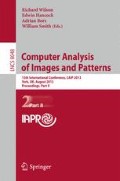Abstract
This paper investigates the recognition of the Eye Accessing Cues (EACs) used in Neuro-Linguistic Programming (NLP) and shows how computer vision techniques can be used for understanding the meaning of non-visual gaze directions. Any specific EAC is identified by the relative position of the iris within the eye bounding box, which is determined from modified versions of the classical integral projections. The eye cues are inferred via a logistic classifier from features extracted within the eye bounding box. The here proposed solution is shown to outperform in terms of detection rate other classical approaches.
Access this chapter
Tax calculation will be finalised at checkout
Purchases are for personal use only
Preview
Unable to display preview. Download preview PDF.
References
Fasel, B., Luettin, J.: Automatic facial expression analysis: A survey. Pattern Recognition 36(1), 256–275 (1999)
Ekman, P.: Emotion in the Human Face. Cambridge Univ. Press (1982)
Bandler, R., Grinder, J.: Frogs into Princes: Neuro Linguistic Programming. Real People Press, Moab (1979)
Fogg, A.: Nlp representational systems and eye accessing cues (2006), http://www.golf-hypnotist.com/nlp-representational-systems-and-eye-accessing-cues/
Hansen, D., Qiang, J.: In the eye of the beholder: A survey of models for eyes and gaze. IEEE Trans. on PAMI 32(3), 478–500 (2010)
Nakazawa, A., Nitschke, C.: Point of gaze estimation through corneal surface reflection in an active illumination environment. In: Fitzgibbon, A., Lazebnik, S., Perona, P., Sato, Y., Schmid, C. (eds.) ECCV 2012, Part II. LNCS, vol. 7573, pp. 159–172. Springer, Heidelberg (2012)
Diamantopoulos, G.: Novel eye feature extraction and tracking for non-visual eye-movement applications. PhD thesis, Univ. of Birmingham (2010)
Viola, P., Jones, M.: Robust real-time face detection. IJCV 57(2), 137–154 (2004)
Feng, G.C., Yuen, P.C.: Variance projection function and its application to eye detection for human face recognition. Pattern Recognition Letters 19(9), 899–906 (1998)
Zhou, Z.: Projection functions for eye detection. Pattern Recognition 37(5), 1049–1056 (2003)
Wu, J., Zhou, Z.H.: Efficient face candidates selector for face detection. Pattern Recognition 36(5), 1175–1186 (2003)
Boykov, Y., Kolmogorov, V.: An experimental comparison of min-cut/max-flow algorithms for energy minimization in vision. IEEE Trans. on PAMI 26(9), 1124–1137 (2004)
Comaniciu, D., Meer, P.: Mean shift: A robust approach toward feature space analysis. IEEE Trans. on PAMI 24(5), 603–619 (2002)
Meyer, F.: Topographic distance and watershed lines. Signal Processing 38, 113–125 (1994)
Valenti, R., Gevers, T.: Accurate eye center location and tracking using isophote curvature. In: CVPR, pp. 1–8 (2008)
le Cessie, S., van Houwelingen, J.: Ridge estimators in logistic regression. Applied Statistics 41(1), 191–201 (1992)
Valstar, M., Martinez, T., Binefa, X., Pantic, M.: Facial point detection using boosted regression and graph models. In: CVPR, pp. 2729–2736 (2010)
Jesorsky, O., Kirchberg, K.J., Frischholz, R.W.: Robust face detection using the hausdorff distance. In: Bigun, J., Smeraldi, F. (eds.) AVBPA 2001. LNCS, vol. 2091, pp. 90–95. Springer, Heidelberg (2001)
Author information
Authors and Affiliations
Editor information
Editors and Affiliations
Rights and permissions
Copyright information
© 2013 Springer-Verlag Berlin Heidelberg
About this paper
Cite this paper
Vrânceanu, R., Florea, C., Florea, L., Vertan, C. (2013). NLP EAC Recognition by Component Separation in the Eye Region. In: Wilson, R., Hancock, E., Bors, A., Smith, W. (eds) Computer Analysis of Images and Patterns. CAIP 2013. Lecture Notes in Computer Science, vol 8048. Springer, Berlin, Heidelberg. https://doi.org/10.1007/978-3-642-40246-3_28
Download citation
DOI: https://doi.org/10.1007/978-3-642-40246-3_28
Publisher Name: Springer, Berlin, Heidelberg
Print ISBN: 978-3-642-40245-6
Online ISBN: 978-3-642-40246-3
eBook Packages: Computer ScienceComputer Science (R0)

